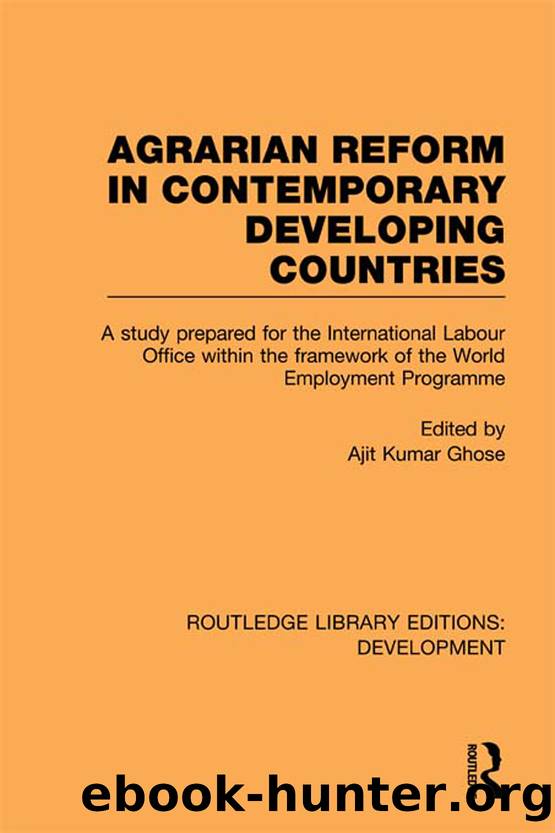Agrarian Reform in Contemporary Developing Countries by Ghose Ajit Kumar;Ghose Ajit Kumar;

Author:Ghose, Ajit Kumar;Ghose, Ajit Kumar;
Language: eng
Format: epub
Publisher: Taylor & Francis Group
Notes
1. R. Pankhurst, âNineteenth, Early Twentieth Century Population Guessesâ, Ethiopia Observer 5, no. 2 (1961); also Urbanization in Ethiopia, Bulletin no. 9 (Central Statistical Office, Addis Ababa, 1972).
2. There are a number of sound studies of the agrarian question and land tenure systems of Ethiopia. See in particular Allan Hoben, Land Tenure among the Amhara of Ethiopia: The Dynamics of Cognitive Descent (University of Chicago Press, Chicago, 1973); John Markakis, Ethiopia: Anatomy of a Traditional Polity (Clarendon Press, Oxford, 1974); Addis Hiwet, âFrom Autocracy to Revolutionâ, Review of African Political Economy (London), Occasional Paper no. 1 (1975); Michael Stahl, Ethiopia: Political Contributions in Agricultural Development (Raben and Sjojrent, Stockholm, 1974): John M. Cohen and Dov Weintraub, Land and Peasant in Imperial Ethiopia (Van Gorcum, Assen, Netherlands, 1975); Patrick Gilkes, The Dying Lion: Feudalism and Modernization in Ethiopia (Julian Friedman, London, 1975); S. F.Nadel, âLand Tenure on the Eritrean Plateauâ, Africa, vol. XVI (1946); Mahtama Sellassie W/Meskel, âLand Tenure and Taxation from Ancient to Modern Timesâ, Ethiopia Observer 4, no. 5 (1964); John M. Cohen, âPeasants and Feudalism in Africa: The Case of Ethiopiaâ, Canadian Journal of African Studies, vol. VIII, no. 1 (1974).
3. J. Markakis and Nega Ayele, Class and Revolution in Ethiopia (Spokesman Press, Nottingham, 1977).
4. For an interesting discussion of class formation in the southern regions of Ethiopia, see Markakis, Ethiopia, pp. 104-40; Hiwet, âFrom Autocracy to Revolutionâ, pp. 30-8.
5. Seleshi Wolde Tsadik, Land Ownership in Hararghe Province (Dire Dawa, HSIU, Ethiopia, June 1966), p. 21. This situation was quite widespread in almost all the southern provinces. Data collected for four weredas in Jimma awraja show that before the revolution 0.25 per cent of the total population owned about 18 per cent of the privately held land (Mesfin Kinfu, in Proceedings of the Social Science Seminar (IDR, 1974), p. 159).
6. Net harvest is what remains after the seed for the next harvest is set aside, and after tithes and sometimes taxes are paid on behalf of the landowner. An interesting insight is provided by Amit Bhaduri, who argues that the practice of deducting the required seed for the next harvest before the sharing of the produce implies that the tenant is in effect lending the landowner a part of the working capital, free of interest. See Amit Bhaduri, âAgricultural Backwardness under Semi-feudalismâ, Economic Journal, vol. 83, no. 1 (1973), pp. 120-4.
7. Branislav, Gossovic, UNCTAD, Conflict and Compromise (A. W. Sijthoff, Leiden, n.d.) pp. 163-4, 282-3.
8.Fassil G. Kiros et al, âThe Urban Bias of Ethiopia's Developmentâ in Fassil G. Kiros (ed.), Introduction to Rural Development (Institute of Development Research, Addis Ababa University, 1977), p. 41.
9. Planning Commission Office, Ethiopia, Report on Current Economic Situation in Ethiopia (Addis Ababa, 1976), Appendix 1.1.
10. G.Gill, âImproving Traditional Ethiopian Farming Methods: Misconceptions, Bottlenecks and Blind Alleysâ, Rural Africana, no. 28 (1975), p. 109.
11. The concentration of oxygen in a grain pit varies according to the level of the grain: the higher the concentration of oxygen, the greater the infestation of grain by insects. Wubshet Teferra, Land Use Study of Ten Farmers at Gende Maya (Dept.
Download
This site does not store any files on its server. We only index and link to content provided by other sites. Please contact the content providers to delete copyright contents if any and email us, we'll remove relevant links or contents immediately.
International Integration of the Brazilian Economy by Elias C. Grivoyannis(74627)
The Radium Girls by Kate Moore(11619)
Turbulence by E. J. Noyes(7700)
Nudge - Improving Decisions about Health, Wealth, and Happiness by Thaler Sunstein(7240)
The Black Swan by Nassim Nicholas Taleb(6762)
Rich Dad Poor Dad by Robert T. Kiyosaki(6174)
Pioneering Portfolio Management by David F. Swensen(6078)
Man-made Catastrophes and Risk Information Concealment by Dmitry Chernov & Didier Sornette(5645)
Zero to One by Peter Thiel(5488)
Secrecy World by Jake Bernstein(4388)
Millionaire: The Philanderer, Gambler, and Duelist Who Invented Modern Finance by Janet Gleeson(4092)
The Age of Surveillance Capitalism by Shoshana Zuboff(3983)
Skin in the Game by Nassim Nicholas Taleb(3965)
The Money Culture by Michael Lewis(3846)
Bullshit Jobs by David Graeber(3826)
Skin in the Game: Hidden Asymmetries in Daily Life by Nassim Nicholas Taleb(3720)
The Dhandho Investor by Mohnish Pabrai(3560)
The Wisdom of Finance by Mihir Desai(3523)
Blockchain Basics by Daniel Drescher(3327)
